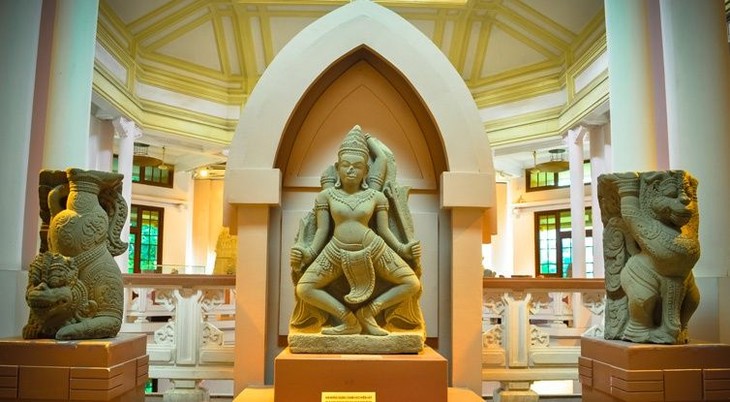(VOVworld) – The Vietnam National Museum of History, with its French architectural style, is one of the most attractive museums in Asia. It contains a large collection of valuable objects depicting Vietnam’s history of construction and defense.
The Vietnam National Museum of History opened on September 26, 2011, integrating the Vietnam History Museum and the Museum of the Vietnamese Revolution. These two museums were the first museums in Vietnam. The Vietnam History Museum was at 1 Trang Tien street in the 1926 building that previously housed the Louis Fino Museum of the French School of the Far East. The Museum of the Vietnamese Revolution was at 25 Tong Dan street in a colonial building the Commercial Department of Indochina built in 1917. These two museum buildings, adjoining the Hanoi Opera House, make up an impressive architectural complex.
The museum’s 4000 square meters displaying more than 10,000 documents and objects gives visitors a broad overview of the development of Vietnam from the prehistoric period through the national formation period 4000 years ago, the feudal dynasties, the national liberation struggles, and the national uprising and birth of the Democratic Republic of Vietnam on September 2, 1945. The museum introduces the national resistance wars and the Vietnamese people’s achievements in national construction and development.
A British tourist, Emma Healy, says she is interested in ancient Vietnamese axes: "It's great to discover Vietnamese history in an old and quiet place like this. The objects presented here interest me much. I also like the lighting and showroom system. "
A corner on the first floor exhibiting 7 bronze drums inspires a lot of tourists. They are the Dong Son, Ngoc Lu, Nong Cong and Thanh Vinh drums arranged around a pillar engraved with patterns of cranes and ancient Vietnamese people. Objects illustrating religious practices during the Tran dynasty including decorative items and photos of pagodas and towers are also exhibited. On the first floor, visitors can discover many items from the Tran dynasty like Pho Minh pagoda in Nam Dinh, Kiep Bac Temple in Hai Duong and Binh Son stupa in Vinh Phuc.
The second floor is devoted to the history of Vietnam from the Ho Dynasty until the revolution of August 1945. A replica of a tortoise carrying stone stele with paintings of culture figure Nguyen Trai on the two sides and ancient books are displayed in a central area of the second floor. On the right side are exhibits showing Vietnamese life under the Ho, Le, Mac, Tay Son and Nguyen regimes. Josh Terry is a tourist from Canada: “A lot of things interest me here: jars dating from the Ly dynasty with a very sophisticated technique, Buddha statues, pagodas, bells and wood carvings. All are beautiful. The objects are very diverse and reveal an interesting history of Vietnam”.
 |
In another showroom, Kajimura Kyoto, a Japanese visitor takes notes and sometimes requests explanations from a Vietnamese friend: "There, there are dishes decorated with beautiful patterns. They do not exist in Japan. I also like this embroidery picture with 100 words about longevity. The art of embroidery in Vietnam has reached a very high technical level. Through these objects, I better understand the Vietnamese culture and traditions. "
On the second floor visitors can also see a collection of stone sculptures of the Champa and Oc Eo-Phu Nam cultures. The Champa stone sculpture collection is arranged in chronological order, from the 7th century to the 13th century with fifty samples collected in the central provinces of Quang Binh, Quang Nam and Binh Dinh.
Visiting the other building on Tong Dan street, you can discover the modern history of Vietnam from 1858 to the present. There are 29 small rooms exhibiting documents and objects featuring the Vietnamese people’s struggle against the French colonialists and American imperialists. The Vietnam National Museum of History, situated in a magnificent architectural complex and offering rich and diverse collections, interesting activities, and thematic exhibitions on Vietnamese culture and history, is a popular destination.